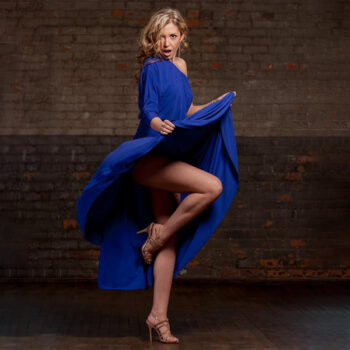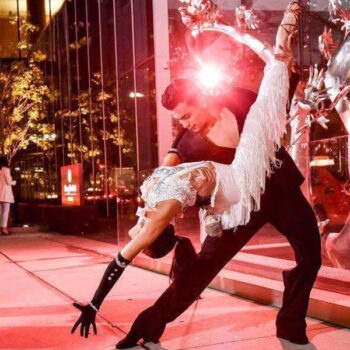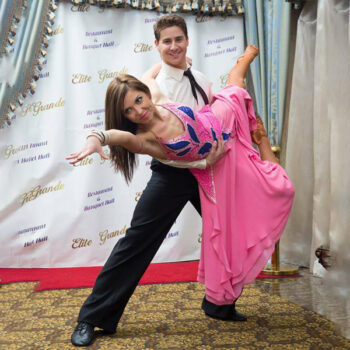A compelling art form that combines grace, accuracy, and artistic expression is ballroom dancing. Ballroom dances have developed into a treasured pastime enjoyed by people of all ages and backgrounds because of its lengthy history and wide range of styles. The significance and symbolism of ballroom dancing will be examined in this article, along with its numerous styles and well-known dances, as well as its fascinating history, how to dance in the ballroom style, and how it got its name.
What is the meaning of ballroom dance?
The pair dance known as ballroom started in the lavish ballrooms of Europe and has since developed into a sophisticated and exquisite art form. It features the coordinated motions of two people, usually a man and a female, who dance together in harmony. Ballroom dancing is a celebration of music and movement, as well as cooperation and teamwork.
What does Ballroom Dance Symbolize?
More than merely a physical activity, ballroom dances also carry deeper metaphorical implications. Perfectly coordinated couples dancing represents their unity and harmony. The complex footwork and exact body motions of ballroom dances are a metaphor for the concentration, commitment, and talent needed to achieve such immaculate coordination. Ballroom dances also exemplify the grace of expression via movement, speech, and conversation.
What are the five famous ballroom dances?
Here is a ballroom dance styles list:
- Foxtrot;
- Viennese Waltz;
- Rumba;
- Argentine Tango;
- Cha-Cha.
Different types of ballroom dance styles
There are many different kinds of ballroom dancing, each with its distinctive methods, rhythms, and cultural influences. Let's take a look at the characteristics of:
- Foxtrot is a fluid, sophisticated dance that is both elegant and laid-back. A common dance known for its extended, uninterrupted moves and elegant spins, the foxtrot is commonly associated with the golden age of Hollywood.
- An elegant and traditional dancing form, the Viennese waltz is usually performed to calming music. The dancers glide and twirl in a sequence of elegant motions as they circle the dance floor.
- A sensual, rhythmic Latin dance form with Cuban roots is the rumba. Because the rumba style places a lot of emphasis on hip and body movements, dancers can convey passion, sensuality, and a wide spectrum of emotions through their movements.
- Argentine Tango is a passionate, national dance style that has its roots in Argentina. Tango is distinguished by its swift, staccato movements, and intense facial emotions. It has a sensual, tense, and romantic vibe.
- Cha-Cha is a vibrant Latin dance style with Cuban roots. The cha-cha is characterized by quick, syncopated steps, dynamic hip movements, and a captivating beat. It radiates vitality, enthusiasm, and flirtatiousness.
What is a ballroom dance example and description?
The Viennese Waltz is a well-known example of a ballroom dance. It is a quick-moving dance form distinguished by gracefulness and sweeping circular moves. The Viennese Waltz was created in Vienna, Austria, in the 18th century, and is frequently related to the splendor of ballroom occasions. Dancers do beautiful revolutions as they move around the dance floor, producing an enthralling spectacle.
Why do they call it a ballroom?
"Ballroom" is a noun that derives from the Latin verb "ballare", which means "to dance". It alludes to a sizable space created especially for parties and dances. Historically, nobles and aristocracy would throw expensive gatherings and formal dances in the luxurious ballrooms located in palaces and vast estates. As time went on, the word "ballroom" evolved to refer to the style of dancing done in these opulent settings, giving rise to the term "ballroom dance."
How to dance ballroom style?
A fun and gratifying journey can be had when learning ballroom dance style. You can follow these recommendations to help you become a modern ballroom dance master:
- Look for a reputed dance school: Find a dance instructor or studio that focuses on Latin dances. You will receive the necessary direction, technique teaching, and a welcoming learning environment from them.
- Select a dance genre: Choose the type of ballroom dancing you want to learn. Focus on one dance form at a time to lay a strong foundation, whether it's the elegant Viennese Waltz, the fervent ballroom Tango, or any other.
- Enroll in beginner-level classes: Sign up for ballroom dance lessons. These classes are created to teach you the fundamental movements, skills, and partnering abilities particular to the dance genre you have selected. Be kind to yourself while you practice and develop.
- Practice frequently: Regularly practice outside of class to hone your abilities. Set aside time for focused practice to improve coordination, muscle memory, and reinforcement of the steps. If you can, practice with a partner, but solitary practice is also beneficial.
- Pay attention to technique: Focus on good posture, footwork, and body alignment. Strong frame, connection with your partner, and flowing movements are essential elements of ballroom dances. To dance with grace and precision, work on perfecting your technique.
- Participate in social dance activities where you can practice your moves with various partners, such as dance parties or practice sessions. Social dances let you practice what you've learned in a practical context and improve your capacity to adjust to various partners and musical styles.
Ballroom dance moves
Any international style can be built upon mastering the fundamentals of ballroom dances. Here are some essential steps used frequently in ballroom dances:
- Box Step: This fundamental step can be seen in many ballroom dances, as a lindy hop. The steps are front, side, together, and backward, all in a square pattern. The Box Step teaches you how to transfer your weight properly and improves your coordination and balance.
- Rise and Fall: The slow Waltz and Foxtrot both employ the rise and fall approach. Moving across the dance floor involves a coordinated lowering and rising motion. With the use of this technique, you may give your motions more grace, fluidity, and a sense of flow.
- Promenade: When partners promenade, the guy is often facing forward and the woman is usually facing backward. It enables graceful sweeping movements and highlights the bond between lovers.
- Turns: A crucial part of ballroom dancing is turns. They give your routines personality and variation. The underarm turn, spot turn, and pivot turn are common turn variations. Maintaining balance, spotting (focusing your eyes), and employing the right body alignment are the major considerations when turning.
- Swivels: Dances like the Cha-Cha and Rumba frequently employ swivels. They entail the hips pivoting while the upper body remains straight. Swivels provide your dance rhythm, flare, and playfulness.
The History of ballroom dance
The history of ballroom dances is very long and fascinating. East Coast Swing, a lively and energetic style of modern ballroom dancing, gave the dance floor excitement and jazz flavor. After reading this you will be able to better understand the cultural significance and special appeal of this ancient art form. So now we will take a closer look at the history of the emergence of ballroom dances and plunge into the atmosphere of past centuries.
The origin of ballroom dance
West Coast Swing was first mentioned in the 16th and 17th centuries as a court style. These dances were once only performed in elaborate settings and opulent ballrooms for the aristocracy and royalty. They served as a means of displaying social standing, manners, and elegance.
These ceremonial court dances eventually started to combine elements of French, Italian, and English dances, as well as influences from other countries and genres. This confluence resulted in the creation of ballroom dance, a more open-minded and approachable style of partner dancing.
Ballroom dancing became increasingly popular during the 19th and 20th centuries, transcending the upper classes and reaching a wider audience. It became a popular activity at social events, in dance clubs, and even in mainstream entertainment venues like theaters and movies. A larger variety of musical genres and regional influences were incorporated into ballroom dance as it started to develop.
Ballroom dance continued to expand and improve as standardized dance styles and organized competitions emerged. Professional dancers and instructors were instrumental in creating competitive ballroom dance styles, codifying the movements, and setting the rules and guidelines.
Ballroom dancing nowadays still pays homage to its historical roots while evolving and adjusting to contemporary tastes. It continues to be a well-liked pastime for both amateur and professional dancers, providing an alluring fusion of custom, imagination, and artistic expression.
Conclusion
Ballroom dancing is a very interesting art form. This dance combines mesmerizing music, harmony between partners, and passion. Ballroom dancing never ceases to amaze and inspire both dancers and spectators. You can plunge into the atmosphere of ballroom dancing by dancing on stage. Or enjoy a professional performance by dancers with experience. Exploring the world of ballroom dancing opens the door to self-expression, creativity, and enjoyment, whether you are a beginner, an experienced dancer, or a lover of pageantry.




